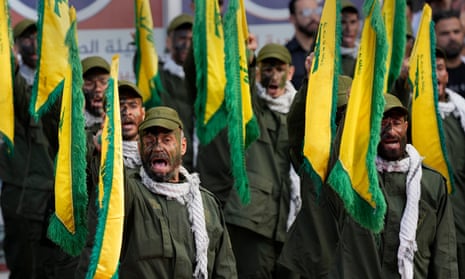The Party of God
Hezbollah, or the Party of God, is one of the most important Islamist movements in the Middle East. Based in Lebanon, it has a powerful military wing, which is the focus of current concern, but it also runs a political party that wields decisive influence, TV stations and an extensive network of welfare services including clinics and schools. Its sprawling business interests, both licit and illicit, bring in hundreds of millions of dollars.
This wide range of resources and its close links with Iran and Syria have helped the Hezbollah overcome multiple challenges in its 40-year existence. Iran’s Islamic Revolutionary Guards Corps played a key role at the organisation’s very beginnings and have effectively mentored what Tehran sees as a key proxy ever since. Hezbollah is a regional player, and its specialists are reported to have been deployed to Iraq to train Shia militias and Yemen to work with Houthi rebels.
A history of violence
Since its foundation by a group of radical Shia clerics in 1982, Hezbollah has been blamed for major and bloody acts of violence in Lebanon, against Israel and internationally too. Terrorism experts see it as a pioneer of mass casualty suicide attacks.
Designated as a terrorist organisation by the US, Israel and some other countries, Hezbollah controls much of Lebanon’s majority Shia areas: southern Beirut, southern Lebanon, and the eastern Bekaa Valley.
Relations between Hezbollah and the Palestinian faction Hamas are not always good. Hamas is an offshoot of the Sunni Muslim Brotherhood movement, while Hezbollah’s ideological wellspring is the Iranian revolution.
The two groups fell out over Syria during the civil war, when Hamas refused to back the government of Bashar al-Assad. But representatives of both – and Iranian security officials – consult regularly. All are dedicated to the destruction of Israel and oppose any normalisation of ties by Arab or Muslim states.
Though there is no evidence of direct involvement, experts see the influence of Hezbollah in the Hamas atrocities in Israel 10 days ago.
“There is no doubt that Hamas had Hezbollah input. This was straight out of the Hezbollah playbook,” said Matthew Levitt, at the Washington Institute for Near East Policy.
The threat now
A recent video showing fighters training with sniper rifles, skis and skidoos in the mountains of Lebanon may have exaggerated some of Hezbollah’s military capabilities but few analysts doubt that these are significant.
Hezbollah has a force of 20,000 fighters, many highly trained and well armed, which could be rapidly expanded by calling up 30,000 part-timers, then augmented further with less well trained auxiliaries, said Naveed Ahmed, an independent Gulf-based analyst specialising in Hezbollah.
Many Hezbollah commanders gained useful experience in battles in Syria, where the organisation deployed en masse to reinforce Assad’s regime, and experts say Hezbollah’s stronghold in southern Lebanon is now defended by a system of deep bunkers, tunnels and underground storage depots.
Crucially, Hezbollah has vast stocks of long-range missiles, which could strike almost anywhere in Israel and overwhelm defensive shields to destroy essential infrastructure as well as hit population centres. Recent Israeli airstrikes in Syria are likely to have been aimed at interdicting further supplies reaching Hezbollah from Iran.
“They are arming to the teeth. They have stockpiled missiles, lots of artillery shells … they have long-range drones capable of carrying full payloads. It’s a very skilful and advanced military organisation after its experience in Syria,” said Ahmed.
War between Israel and Hezbollah
If Hezbollah’s leaders (or more likely Tehran) decide in favour of escalating current low-level hostilities this could lead to a bloody and difficult two-front conflict for Israel and so – potentially – to a regional conflagration as Syria, Iran, the US and other actors become involved.
Some analysts believe that Hezbollah, though dedicated to the destruction of Israel, has too much to lose to risk an all-out conflict, given its political and extensive commercial interests. Many suggest Hezbollah has for some time been looking to provoke a short, limited war but wants to avoid anything bigger. All agree there is a considerable risk of a fatal miscalculation in such a tense environment, however.
One additional factor is the massive US force now steaming into the eastern Mediterranean, dispatched with the explicit intention of intimidating Hezbollah and its patrons in Tehran.
“No one – not even a sovereign nation – is going to ignore two aircraft carrier groups. It doesn’t stop them doing small – scale attacks but it will make [Hezbollah] think very carefully about doing anything bigger,” said Levitt.
The dramatically changed circumstances after the 7 October attacks mean conventional wisdom on how organisations such as Hamas or Hezbollah behave no longer holds true. This makes the future very difficult to predict – and so that much more dangerous.
